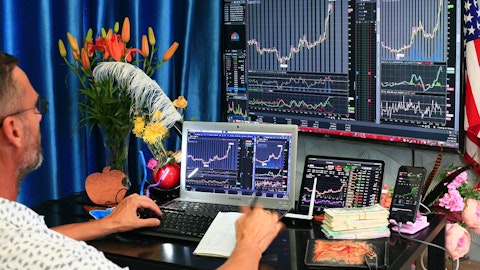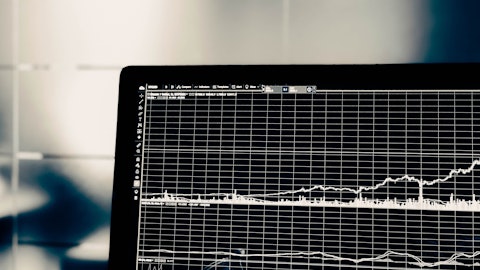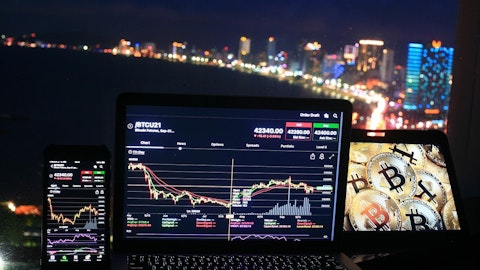Josh Siegler: Great. No, I appreciate the color there, Geoff, and it actually leads into my next question, which is around the having. So obviously you guys are uniquely positioned to replace some of your older legacy machines with some more highly efficient machines, which could both improve your efficiency overall and increase your hash. I was curious how you’re thinking about the timing of that come having. Would you look to be aggressive as we enter to having? Or is it really a wait and see approach to see what’s happening across the network?
Geoff Morphy: Well, as we’ve said many times, we want to have the balance sheet and margins and management team to be able to be opportunistic. And opportunistic means that really, this window has really only opened in the last two weeks, maybe two and a half weeks with the announcement of these miners, we’re looking at things very closely. The having is very much in focus for April 15, April 16, April 21, whenever the mathematicians have best estimated right now. But we have opportunities to plug them in before the having. It’d be nice to be able to do that, but there’s no commitments and no decisions made just yet. But we’re working on a variety of scenarios.
Josh Siegler: Got it. Thank you, Geoff.
Operator: Our next question comes from Chase White with Compass Point Research. Please go ahead.
Chase White: Thanks for taking my questions. So a couple, if I may. First is a housekeeping question. So what were the – apologies, if I missed this, but what were the power costs in Argentina during the quarter? The average cost.
Geoff Morphy: So generally the cost for the quarter were just a little. Overall, we’re a little over $0.03. But what I want to underscore here is that one that did include the winter months to degree that came into play here a little bit. And then secondly, during this quarter, we did revert over entirely to getting the energy cost from private producer, where there was earlier in the quarter some contribution from the grid itself as we were making that transition, which was higher cost. So again, overall, though, for Argentina, we were just over $0.03 for the quarter. And by the way, I’m going to add here that in September, instead of being foreign exchange influence, our cost was about $0.028 of energy for Argentina.
Chase White: Got it. That’s helpful. And how should we think about CapEx for the remainder of this year and how much should be left over as we head into next year? Obviously, you’ve got some minor purchases that you need to make and don’t necessarily know the exact pricing for that. But in terms of the infrastructure and then how many miners you would contemplate putting in there? Any comments on that? Thanks.
Jeff Lucas: Sure. Let me start this off. And Geoff, you can certainly fill in, in terms of some of the minor counts there if you wish. So, first of all, I’m just going to speak to what we have in terms of our disclosed and communicated CapEx and our growth plans. We have other initiatives about which we spoke to regarding what we’re doing with the minor fleet and things of that sort here. But the thoughts to keep in mind at this point here is that the major project we really have here is the development of Paso Pe, which, as Geoff indicated, will be up and running by the end of the first quarter of 2024. We also have what’s going on, we’ve identified Baie-Comeau that was a $22 million revenue [ph], excuse me, 22 megawatt acquisition we announced in April.
We’ve got the first 11 up and running, and we’re scheduled to have the second 11 in the second half of 2024. We also have some smaller projects in the works, generally a $1 million or less in Washington, some improvements there, and even some sort of minor modifications as well that we have going for another $1 million or so. So overall, what we’re looking for, to be very specific here, is about $70 million of CapEx commitment that we’ve identified between now and the end of 2024. Of that amount, just to be clear here, roughly $50 million to $55 million of that is going to be Paso Pe. We’re bringing a play again up and running by the end of March. And we have the Baie-Comeau, the second 11 megawatts, maybe an additional $10 million to $15 million.
That’ll be in the second half of 2024. And then the additional little dogs and cats, so to speak, that we have that beginning filtered out through the remaining months here.
Geoff Morphy: Yes, Chase, as Jeff mentioned, the Paso Pe facility, we’ve got 20 megawatts spoken for with the hydro miners, which is fantastic that we’re going into that new technology there. But we haven’t announced the 30 megawatts that are from the air cooled facilities. So great opportunity to do our own mining, our own hashing at that location with those 30 megawatts. The other upgrades that Jeff mentioned are later in the year, but sooner than that if we can really put things together, a fleet upgrade, we have over 16,000 M30s, M31s that are primarily in Quebec. Talking about the opportunity for rapid increases in hashrate and rapid improvements in efficiency by replacing some of those M30s and M31s with T21s, S21s that type of series of minor. You’re talking 46%, 50% improvement in efficiencies right away. So we’re looking at that very keenly.
Chase White: Got it. It helpful. Thanks guys.
Operator: The next question comes from Kevin Dede with H.C. Wainwright. Please go ahead.
Kevin Dede: Hi, gents. Thanks for taking my question.
Geoff Morphy: Good morning, Kevin.
Jeff Lucas: Hey Kevin.
Kevin Dede: Yes. You gentlemen alluded to a seven exahash target, I think, for the – did you say the end, Geoff, the end of the first quarter next year?
Geoff Morphy: Correct. Correct.
Kevin Dede: Okay. Could you give us a little more detail on how you see, I think, whatnot – we’re at about 6.3 now. Can you just walk through the step function improvement there? And given that some of that is a function of the M50 and M56 order, I’m just kind of trying to figure it out in my little brain on shipment and deployment?
Geoff Morphy: Yes. We’ve announced a lot of new miners, but most of them are now into Argentina and plugged in now. So you’re not really going to see – you’re going to see a little bit more coming from Rio Cuarto to Argentina. But really, this is all about Paso Pe and the 20 megawatts dedicated to the hydro miners and the hydro containers that we have there. That’s really the step function that will get you to seven exahash. The 30 megawatts in the air cooled facilities there, we’re building the air cooled warehouses, but we have not announced what’s going in there yet or how it’s going to be configured. So that does not go into the seven exahash. Arguably, if we put our own miners in those air cooled facilities, then we could be probably up to the eight exahash area and perhaps a little more, but right now that’s how we get to the seven.
Kevin Dede: So what machines do you have ordered, Geoff? Just to seven, right? So if you go to eight, you’d have to place orders?
Geoff Morphy: Correct.



